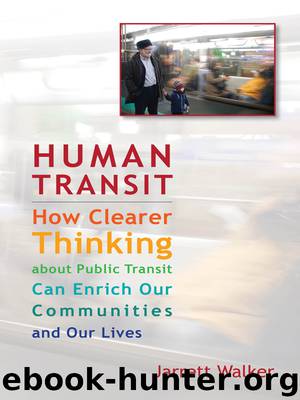Human Transit by Jarrett Walker

Author:Jarrett Walker
Language: eng
Format: epub
ISBN: 9781610911740
Publisher: Island Press
Published: 2012-06-17T16:00:00+00:00
DENSEVILLE’S INTENSIFICATION EFFECTS
Up to now, we’ve assumed that everyone in both communities is equally likely to use public transit. But that assumption is not quite right, because the difference in density implies other important differences between these two communities.
Private cars, which require space for parking, are easy to maintain in Sparseville, because there’s plenty of room for them. Owning a car in Denseville is more of a hassle. Denseville residents who drive are more likely to “pay” for parking—either in money, via paid parking lots or permits, or in time, by having to drive around for a long time before finding a spot.
Denseville residents also have less need to drive. A Denseville resident can probably walk or bike to a grocery store and some other necessities of life, while most Sparseville residents need cars to reach these things. Because there is more walking in Denseville, there are likely to be better sidewalks with more lighting. High density means more pedestrians, and that means walking feels safer, because you are less likely to be totally alone as a pedestrian on the street. These features are crucial parts of an attractive transit experience, because every transit rider is also a pedestrian.
Because of these differences, all of which tend to follow from the difference in density, Denseville residents typically have lower rates of car ownership. It is not that they can’t afford cars. They simply don’t need cars as much as Sparseville residents do. In Denseville, a family may need only one car for two or three adults, while in Sparseville there may be a car for every adult, or even more.
Up to now, we’ve assumed that Denseville and Sparseville residents are equally likely to use transit, but clearly that can’t be right. An individual resident of Denseville is more likely to find transit attractive than an individual in Sparseville. So the rate of transit use per citizen will be higher in Denseville.
A 1996 study by Parsons Brinckerhoff found exactly that: transit ridership per person rises directly with density.2 Note carefully what this is saying. We’ve seen that ridership rises with density because density means more people, but that’s a different point. We’re saying that each of those people is more likely to use transit if he or she lives in a denser area.
Now the ridership on our 2-mile segment of line can be calculated like this:
Download
This site does not store any files on its server. We only index and link to content provided by other sites. Please contact the content providers to delete copyright contents if any and email us, we'll remove relevant links or contents immediately.
The Secret History by Donna Tartt(16623)
The Social Justice Warrior Handbook by Lisa De Pasquale(11489)
Thirteen Reasons Why by Jay Asher(7788)
This Is How You Lose Her by Junot Diaz(5772)
Weapons of Math Destruction by Cathy O'Neil(5037)
Zero to One by Peter Thiel(4824)
The Myth of the Strong Leader by Archie Brown(4789)
Promise Me, Dad by Joe Biden(4447)
Beartown by Fredrik Backman(4419)
Stone's Rules by Roger Stone(4415)
How Democracies Die by Steven Levitsky & Daniel Ziblatt(4399)
The Fire Next Time by James Baldwin(4343)
100 Deadly Skills by Clint Emerson(4078)
A Higher Loyalty: Truth, Lies, and Leadership by James Comey(4033)
Rise and Kill First by Ronen Bergman(4012)
The David Icke Guide to the Global Conspiracy (and how to end it) by David Icke(3882)
The Farm by Tom Rob Smith(3872)
Secrecy World by Jake Bernstein(3782)
The Doomsday Machine by Daniel Ellsberg(3731)
